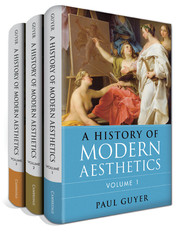Book contents
- Volume 1 The Eighteenth Century
- Volume 2 The Nineteenth Century
- Frontmatter
- Contents
- Acknowledgments
- Introduction
- Part One German Aesthetics in the First Half of the Nineteenth Century
- Part Two (Mostly) British Aesthetics in the Second Half of the Nineteenth Century
- 5 Ruskin
- 6 Aestheticism
- 7 Bosanquet and Tolstoy
- Part Three German Aesthetics in the Second Half of the Nineteenth Century
- Bibliography
- Index
- Volume 3 The Twentieth Century
- References
7 - Bosanquet and Tolstoy
from Part Two - (Mostly) British Aesthetics in the Second Half of the Nineteenth Century
Published online by Cambridge University Press: 05 June 2015
- Volume 1 The Eighteenth Century
- Volume 2 The Nineteenth Century
- Frontmatter
- Contents
- Acknowledgments
- Introduction
- Part One German Aesthetics in the First Half of the Nineteenth Century
- Part Two (Mostly) British Aesthetics in the Second Half of the Nineteenth Century
- 5 Ruskin
- 6 Aestheticism
- 7 Bosanquet and Tolstoy
- Part Three German Aesthetics in the Second Half of the Nineteenth Century
- Bibliography
- Index
- Volume 3 The Twentieth Century
- References
Summary
In this chapter, we look at two more figures who wrote on aesthetics during the 1890s, a period as fruitful as the final decade of the previous century – from Britain, Bernard Bosanquet, and from outside Britain, Leo Tolstoy. Bosanquet, though working within the framework of British Hegelianism, broadened Hegel’s own conception of art in ways compatible with the breadth of spirit we found in Pater and Wilde. Tolstoy, however, in spite of the breadth of mind and spirit manifest in his great novels of earlier decades, above all War and Peace (1869) and Anna Karenina (1877), reacted against a narrow conception of aestheticism with an equally narrow conception of art as exclusively a vehicle for the communication of religious feelings. We might then see the narrowness of aesthetic theory in Britain in the first decades of the twentieth century, to be considered in Volume 3, as a defense of the narrow conception of aestheticism that Tolstoy had attacked in his 1898 tract What is Art?, which was in fact first published in Britain rather than Russia.
Bosanquet
Bernard Bosanquet (1848–1923) was born in Northumberland, the son of an evangelical clergyman, and attended Harrow School and Balliol College, Oxford, where his teachers included the leading British Neo-Hegelian idealists Benjamin Jowett, Thomas Hill Green, and Edward Caird. Upon graduation, he was elected to a fellowship at University College, which he held from 1871 to 1881, when he received an inheritance from his father, moved to London, and devoted himself to philosophy, social work, and adult education. He was active in the Charity Organization Society from 1881 until his death; in the Home, Arts, and Industries Association; in the Ethical Society, where he gave many of the courses of lectures that would later become books; and he chaired the School of Sociology and Social Economics from 1903 until its incorporation into the London School of Economics in 1912. Also in 1903, he returned to academic life as Professor of Moral Philosophy at St. Andrews University in Scotland, but served in that position only five years. Most of his many works were written during his years as an independent scholar and activist in London. Among his early contributions were his translations of the introduction to Hegel’s Philosophy of Fine Arts (1886) and Lotze’s System of Philosophy (1888).
- Type
- Chapter
- Information
- A History of Modern Aesthetics , pp. 270 - 296Publisher: Cambridge University PressPrint publication year: 2014



